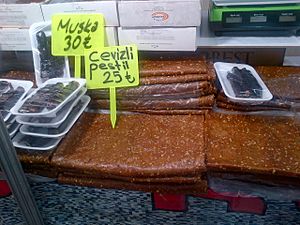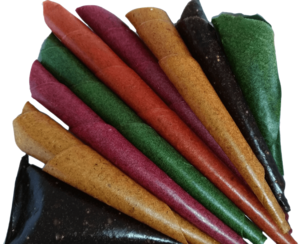Pestil facts for kids
 |
|
| Place of origin | Ottoman Empire (?) |
|---|---|
| Main ingredients | Grape must, nuts, flour |
Pestil, a Turkish word meaning dried fruit pulp, is best exemplified in the English term "fruit leather." Fruit leather is made from mechanically pulverizing fruit, then spreading it out to dry into a tough, yet flexible and edible material which can be kept preserved for several months in an airtight container. In Armenian pestil is called pastel. In Greek it is called pastilos. In some regions of Turkey, including the southeastern city of Urfa, this fruit dessert is also called bastık.
A plum-based dessert from Bulgaria is also called pestil. It's prepared by boiling plums with sugar and water and cooling the mixture in a solid layer. Bulgarian pestil is sometimes thicker than its Turkish counterpart and might be cut in small pieces instead of rolled up.
Pestil might be made with different types of fruit beside plums. Apples, apricots, pears, peaches and melons are popular choices.
Etymology
According to Turkish etymological dictionary Nişanyan Sözlük, Turkish pestil and Italian pastillo are cognates and pastillo might have derived from Italian pastello. The dictionary asserts that the relationship between pestil and French pastille is ambiguous. The oldest written record of the Turkish word is dated back to 1501 dictionary Câmiü'l-Fürs. According to Robert Dankoff, Turkish word derives from Armenian pasteł (պաստեղ, "pastegh" / "fruit leather") which in turn derives from Ancient Greek pastillos (πάστιλλος, "pastille").
See also
 In Spanish: Pestil para niños
In Spanish: Pestil para niños


